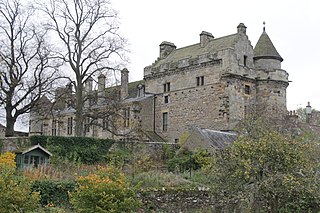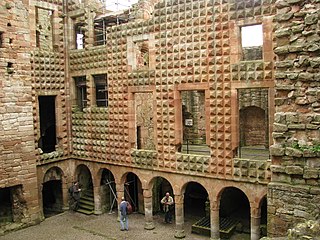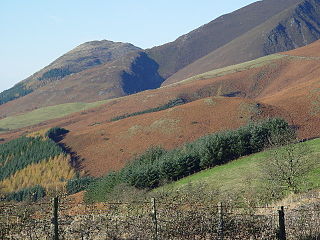
Falkland Palace, in Falkland, Fife, Scotland, is a royal palace of the Scottish Kings. It was one of the favourite places of Mary, Queen of Scots, who took refuge there from political and religious turmoil of her times.

Francis Stewart, 5th Earl of Bothwell, was Commendator of Kelso Abbey and Coldingham Priory, a Privy Counsellor and Lord High Admiral of Scotland. He was a notorious conspirator who led several uprisings against his first cousin, King James VI, all of which ultimately failed, and he died in poverty in Italy after being banished from Scotland. Francis's maternal uncle, the 4th Earl of Bothwell, was the chief suspect in the murder of James VI's father, Lord Darnley.
Sir William Stewart of Houston was a Scottish soldier, politician and diplomat.
Sir John Carmichael was a Scottish soldier, the Keeper of Liddesdale, a diplomat, and owner of Fenton Tower at Kingston, East Lothian.
Robert Bowes (1535?–1597) was an English diplomat, stationed as permanent ambassador to Scotland from 1577 to 1583.

Underskiddaw is a civil parish in the Borough of Allerdale in the English county of Cumbria. The parish lies immediately to the north of the town of Keswick, and includes the southern and eastern flanks of Skiddaw as well as part of the valley of the rivers Greta and Derwent, and a small part of Bassenthwaite Lake. The parish includes the settlements of Applethwaite, Millbeck and Ormathwaite, all of which lie along the line where the southern slopes of Skiddaw meet the valley.
Sir David Foulis was a Scottish baronet and politician.
Sir Richard Cockburn of Clerkington, Lord Clerkintoun (1565–1627) was a senior government official in Scotland serving as Lord Privy Seal of Scotland during the reign of James VI.
Brackenhill Tower is a peel tower, in the parish of Arthuret, in Cumbria, just north of the River Lyne. The site is about 2 miles (3.2 km) north of Kirklinton and 4 miles (6.4 km) east of Longtown, or 10 miles (16 km) north of Carlisle and 8 miles (13 km) east of Gretna Green, and is a good defensive position, with ravines to the north and south. Extensions were added in the 18th and 19th centuries, but the original tower has had little alteration. It is the only remaining example of a Scottish tower house south of the border with England, and became a Grade II* listed building in 1957.
Sir Roger Aston of Cranford, Middlesex, was an English courtier and favourite of James VI of Scotland.
John Stewart, 5th Earl of Atholl, (1563–1595) was a Scottish landowner.
William Selby, was an English member of parliament and soldier at Berwick upon Tweed.
Sir James Sandilands was a courtier to King James VI and I and captain of Blackness Castle
George Nicholson or Nicolson, was an English diplomat in Scotland.

James Scott of Balwearie was a Scottish landowner and supporter of the rebel earls.
James Ogilvy, 5th Lord Ogilvy of Airlie was a Scottish landowner and diplomat.

James Douglas of Spott was a Scottish landowner and conspirator.

The Raid of Holyrood was an attack on Holyrood Palace, Edinburgh on 27 December 1591 by Francis Stewart, 5th Earl of Bothwell in order to gain the favour of King James VI of Scotland. Bothwell subsequently staged a raid at Falkland Palace, and in July 1593 made another attempt at Holyrood.

Mangerton Tower is a ruined Scottish tower castle house formerly belonging to the Armstrong family.

Thomas Musgrave, Captain of Bewcastle was an English landowner and soldier involved in Scottish border politics. He was keeper of Bewcastle Castle for Elizabeth I.








